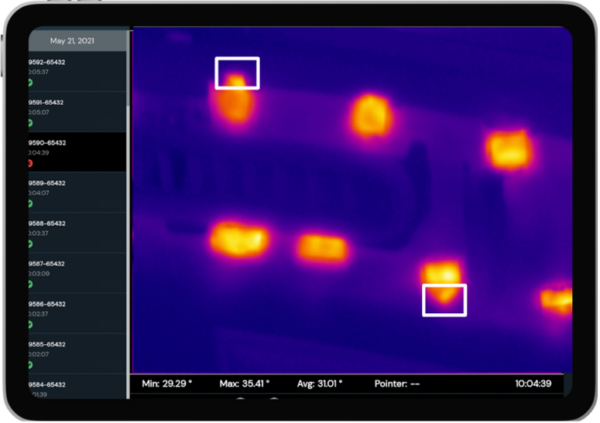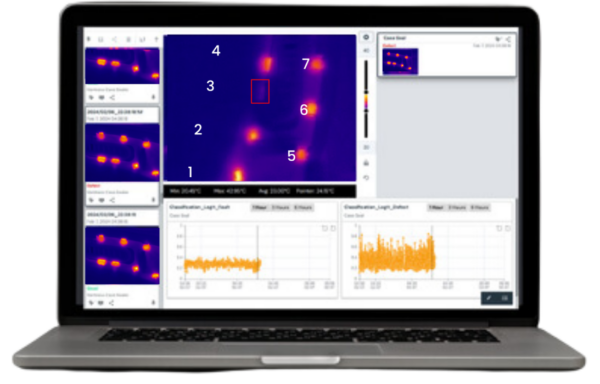In the automotive industry, precision is critical—especially in components like instrument panels, which serve as both the functional and aesthetic heart of a vehicle’s interior. As technology advances, the manufacturing process must evolve to meet higher quality, safety, and performance expectations. One area of focus is welding instrument panels, a complex procedure where precision and consistency are essential.
Traditionally, visual inspections and manual checks have been the go-to methods for assessing weld quality. However, these methods are prone to human error and may miss subtle defects that can compromise the long-term durability of the component. Today, cutting-edge solutions like thermal imaging and artificial intelligence (AI) are transforming the quality inspection process during instrument panel welding, offering manufacturers a more accurate, efficient, and reliable way to ensure the integrity of every weld.

Using thermal images enhanced in our OneView software, factory teams have visibility to welds as they occur. Data collected is used to train an AI inspection model and inspection results for welds on each panel are displayed on an HMI on the at the welder.
The Challenges of Instrument Panel Welding
Instrument panels house various critical components such as gauges, air vents, infotainment systems, and safety features. Ensuring the quality of welds in the back of each panel is essential for maintaining the overall functionality and safety of the vehicle. Common welding methods for instrument panels include ultrasonic and vibration welding, both with unique challenges:
- Inconsistent heat distribution: Uneven heating during welding can result in weak bonds or incomplete welds, leading to potential failures.
- Components or nesting variations: Minor inconsistencies on the parts or improper positioning can result in misalignment, leading to weak welds.
- Hard-to-detect internal defects: Small air pockets or inconsistencies within the material or weld seam can go unnoticed with traditional inspection methods, causing problems later in the vehicle’s life cycle.
To overcome these challenges during production, manufacturers need more advanced, reliable ways to inspect welds as the welds happen. This is where thermal imaging and AI enter the picture.
The Power of Thermal Imaging in Welding Inspection
Thermal imaging technology uses sensors to capture the heat signature of objects and materials. During the welding of an instrument panel, thermal cameras can monitor the thermal footprint of the weld in real-time. This enables manufacturers to detect and address issues like uneven heating or overheating as they happen, reducing the chances of defective welds moving further along the production line. Key benefits of using thermal imaging during instrument panel welding include: real-time monitoring; early defect detection, and “touchless” inspection.
AI-Powered Analysis: Taking Thermal Imaging to the Next Level

Eigen’s integrated inspection solutions also capture process data. When combined with the thermal images. the data becomes a powerful tool for enabling automated inline inspections, in-depth defect analysis and triggering closed-loop automation.
While thermal imaging provides crucial insights into the welding process, analyzing the vast amounts of data generated by thermal cameras can be a daunting task — especially in real-time production environments. This is where AI comes into play. Advanced AI algorithms, particularly machine learning models, can process and analyze thermal data with greater speed and accuracy than manual inspection methods.
Here’s how AI enhances the welding inspection process:
- Automated Defect Detection: AI models can be trained to recognize specific patterns and anomalies in thermal data, identifying defects such as incomplete welds, cold welds, or weak bonds without requiring human intervention.
- Real-Time Analysis: AI-powered systems can analyze thermal data in real time, providing instant feedback and allowing for immediate corrective actions. This helps to minimize downtime and reduce the number of defective parts produced.
- Predictive Insights: AI can go beyond simple defect detection by analyzing patterns across multiple production runs to predict potential issues before they occur.
- Continuous Learning: AI models improve over time. As they process more data, they become better at identifying subtle defects, refining their ability to detect issues early and accurately.
Together, thermal imaging and AI create a powerful inspection system that significantly improves the precision and reliability of welding during instrument panel production.
The Future of Instrument Panel Welding Inspection
As the automotive industry continues to embrace Industry 4.0 and smart manufacturing technologies, the role of AI and thermal imaging in quality control will only grow. Future advancements in AI algorithms, sensor technology, and real-time data processing will make these tools even more powerful, enabling manufacturers to achieve next-level precision and efficiency.
By integrating AI and thermal imaging into the welding process, manufacturers can streamline production, reduce costs, and stay ahead in an increasingly competitive market. Our integrated solutions enable real-time, non-invasive inspections that catch defects early, improve product quality, and reduce costs, making them indispensable tools in modern automotive manufacturing. Early adoption will give you a competitive advantage and help grow your relationships with OEMs with comprehensive inspection data on every weld on every panel.


